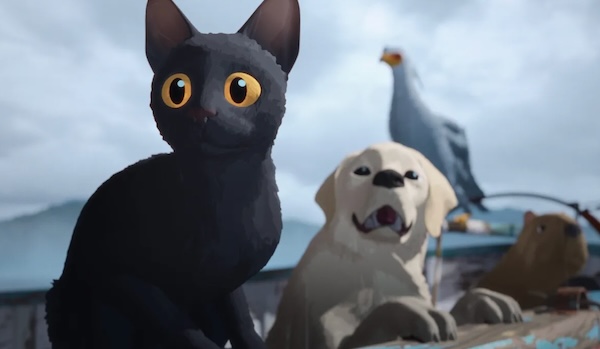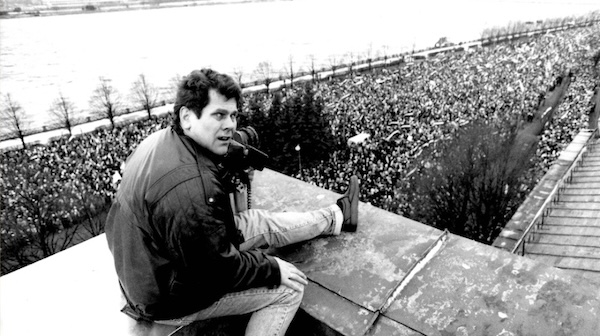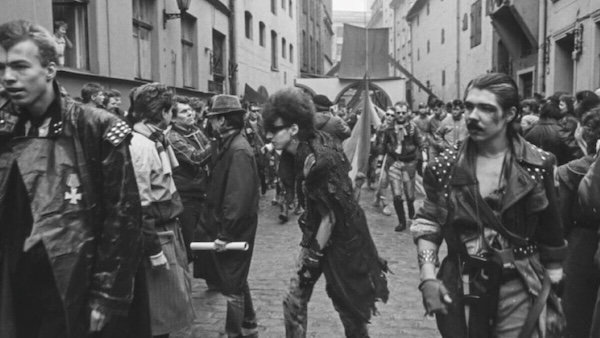Doc Talk: The Boston Baltic Film Festival — Studies in Brilliance
By Peter Keough
A hero of his times: celebrating Latvian pioneering documentarian Juris Podnieks.
The Boston Baltic Film Festival. In person February 28-March 2 at the Emerson Paramount Center and online March 3-17.

Of cats and catastrophe. A scene from Flow
This year the Boston Baltic Film Festival rightfully showcases Gints Zilbalodis’s miraculous masterpiece Flow (screens March 1 at 3:10 p.m. at the Emerson Paramount Center followed by a Q & A with the filmmakers), Oscar-nominated for both Best Animated Feature and Best International Film.
It also celebrates another brilliant Latvian filmmaker, documentarian Juris Podnieks, who electrified Soviet audiences with his Is It Easy to Be Young? (1986), a groundbreaking portrait of a lost generation on the cusp of perestroika, and then courageously recorded the violent events leading to Latvia’s independence from the Soviet Union. Having survived all that, he died tragically in 1992 in a scuba-diving accident. Who knows what his shrewd, compassionate eye might have made of the current, perilous situation, with the Baltic states likely in the crosshairs of Russian aggression?
As depicted in Antra Cilinska and Anna Viduleja’s authoritative documentary Podnieks on Podnieks. A Witness to History (2024; screens February 28 at 6:30 p.m. followed by a Q & A with the filmmakers; also online March 3-17), the subject acknowledges that, if his father hadn’t given him a camera when he was a rowdy teenager, he might have become a lost youth like those in his most famous film. Instead he became a driven genius. His talent, cinematic vision, and humanism are revealed early on in images ranging from a snippet of a little boy alternately wonderstruck and horrified while watching a puppet show, to the ancient faces of veterans from World War I and the Russian Civil War in Constellation of Riflemen (1982).
But not until Is It Easy to Be Young? did the moment, his particular insight and genius, and the subject matter combine into a cultural event seen by nearly 30 million in the Soviet Union, as well as audiences in more than 80 other countries. At first this unflinching portrait of punks, hooligans, cynics, sell-outs, and traumatized veterans of the Afghanistan War looked like it would be banned by the authorities, with Podnieks likely ostracized from the film industry. But, surprisingly, Soviet Premier Mikhail Gorbachev embraced the film, calling it “the first bird of perestroika,” heralding his ongoing policy of liberalizing the USSR politically and culturally. Thus Podnieks met a turning point in Soviet history, advanced it, and embodied it.

The brilliant Latvian documentarian Juris Podnieks. Photo: Baltic Focus
Despite his success and apparent acceptance by the authorities, Podnieks continued to record the truth in his work. In documentaries for the BBC and other venues this dedication became especially fraught as the Soviet system crumbled and the hardliners struggled, often ruthlessly, to maintain power. The process culminated in 1990-1991 as the Baltic states declared their independence and faced the desperate efforts of the dying empire to restore itself.
Podnieks and his film crew first traveled to Vilnius, Lithuania, to film the murderous, failed efforts by Soviet forces there to quash demonstrations for independence. They returned to Riga, Latvia, exuberant and unscathed, to witness similar attempts by Soviet special police, OMON, to seize Latvia’s Ministry of the Interior and the barricades set up by thousands of unarmed demonstrators. This time the film crew wasn’t so lucky: two of Podnieks’s cameramen, Andris Slapins and Gvido Zvaigzne, longtime collaborators and close friends, were killed by sniper fire. In harrowing footage, the mortally wounded Slapins hands over his camera to Podnieks and tells him to keep filming. He does so, recording Slapins’s death as automatic fire rattles and tracer bullets cross the sky.
The images are unforgettable, history in the raw, but the deaths left something broken in Podnieks. He lived to see his beloved Latvia become independent but his own demise — news reports of which Cilinska and Viduleja return to periodically in the course of the film — was anticlimactic and, in the words of his obituary in the Independent, “premature and senseless.”
As the title suggests, Podnieks on Podnieks offers a rich sampling of the filmmaker’s thoughts on cinema, justice, art, and history culled from letters, diary entries, and interviews (they are read in voice-over by Egons Dombrovskis). The documentary also contains a tantalizing selection of excerpts from his films. But for a fuller appreciation of the artistry at work in Is It Easy to Be Young? one needs to view it in its entirety (the festival is screening it and its two Seven Up!–like sequels virtually, March 3 through 17)

A scene from Juris Podnieks’s Is it Easy to Be Young?
Is It Easy to Be Young? opens with footage of a rock concert by the band Pērkons (they had been banned once before and would be banned again after this show). Those in the crowd range from grim-faced parents and police to ecstatic teenagers. Some grew too ecstatic and trashed a railroad car. Out of the over a hundred or so who participated in this vandalism only seven are arrested and tried — all but one received suspended sentences. At the trial Podnieks focuses on the latter, who is at first blasé, then incredulous, then horrified and weeping as he learns that he is facing three years of hard labor for breaking light bulbs. As he leaves, the guy gives his friends, sheepish and perhaps aware that he is a scapegoat for them, a tiny wave. Details like this are a mini-tragedy, dramatizing the fate of an individual before the monolith of an oppressive system (as Cilinska shows in the follow-up documentaries, this callous judgment by a Soviet judicial apparatchik would ruin the young man’s life).
The film catches up with some of the other participants a year later. A young woman, who at the concert was in full rave, now has a baby girl and fears her daughter’s life will be poisoned by the Chernobyl disaster. Another fan remains estranged from society, but he has tried to turn his angst into a short film, a moody, symbolic Bergmanesque opus in which a figure in black, Death, stalks young people in a labyrinth that resembles a haunted house ride. In a deft segue, Podnieks cuts to death in a very literal sense, a youth working as an undertaker’s assistant, slicing up a cadaver like a side of beef (as seen in the sequels, his fate is not a happy one).
Many of the participants at the concert, however, seem to have blandly assimilated into society. A kid seen in shades and a leather jacket in the earlier footage has swapped that regalia for a uniform and is saying how much he loves the discipline of his army training. Countering his gung-ho attitude are the thousand-yard stares of the Afghanistan war veterans. Damaged physically and psychologically, they will never forget their experience, though everyone else has. By achieving independence, Latvia has spared generations from the carnage of Russia’s ceaseless wars. It remains to be seen for how long.
Peter Keough writes about film and other topics and has contributed to numerous publications. He had been the film editor of the Boston Phoenix from 1989 to its demise in 2013 and has edited three books on film, most recently For Kids of All Ages: The National Society of Film Critics on Children’s Movies (Rowman & Littlefield, 2019).
Tagged: "Flow", "Podnieks on Podnieks", Anna Viduleja, Antra Cilinska, Baltic Film Festival, Gints Zilbalodis
